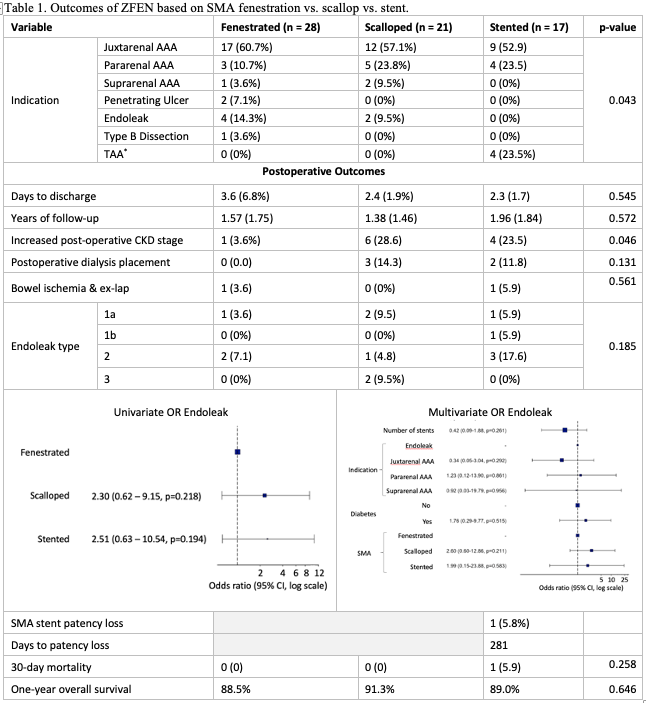SMA Fenestrations, Scallops, And Stents For FEVAR
Peter V. Cooke, BA1, Vikram Vasan, BA1, Justin M. George, MD2, Halbert Bai, MPH1, Aijt Rao, MD2, Michael L. Marin, MD2, Peter L. Faries, MD2, James McKinsey, MD2, Rami O. Tadros, MD2.
1Icahn School of Medicine at Mount Sinai, New York, NY, USA, 2Division of Vascular Surgery, Mount Sinai Hospital, New York, NY, USA.
Objective: The Cook Zenith fenestrated endografts (ZFEN) for abdominal aneurysm repair are designed with a scallop or large fenestration to perfuse the superior mesenteric artery (SMA). Stenting through an SMA scallop or fenestration is an additional surgical option. We compared outcomes of SMA scallops, fenestrations, and stented scallops in the setting of fenestrated EVAR (FEVAR). Methods: We analyzed our institutionís retrospective database of patients who underwent FEVAR from April 2016 to June 2021. Patients were stratified into three cohorts based on the design for SMA perfusion: Scalloped, Fenestrated, and Stented. Outcomes included stent stenosis, stent-related reintervention, endoleaks, bowel-ischemia, exploratory laparotomy, 30-day mortality, and one-year survival. Results: Among 66 patients who fit our criteria, we identified 28 Fenestrated, 21 Scalloped, and 17 Stented SMAs. Demographics and comorbidities were similar between cohorts. The distribution of indications was different between cohorts (p=0.043) (Table). Mean follow-up was 1.6, 1.4, and 2.0 years for the Fenestrated, Scalloped, and Stented groups, respectively. The mean number of ZFEN visceral vessels stented during the index procedure was significantly different between Fenestrated (1.9), Scalloped (1.9) and Stented (3.1) cohorts (p<0.001). The number of endoleaks was not significantly different between cohorts (p=0.334). Types of endoleaks are featured in the Table. One Fenestrated, four Scalloped, and four Stented patients experienced endoleaks that required reintervention (p=0.099). One Stented patient experienced severe stenosis (>90%) of the SMA stent due to mechanical compression. Another Stented patient experienced a type b aortic dissection and required angioplasty and extension of their SMA stent. Patients with scallops or stents were more likely to experience postoperatively decreased kidney function (p=0.046). One (3.6%) Fenestrated, zero (0%) Scalloped, and one (5.9%) Stented patient experienced bowel ischemia, necessitating an exploratory laparotomy (p=0.561). The Stented patient with bowel ischemia passed away 28 days after ZFEN and was the only patient in our study with 30-day postoperative mortality. One-year survival was not significantly different between cohorts- Fenestrated: 100%, Scalloped: 95.2%, and Stented: 88.2% (p=0.11).
Conclusion: Similar outcomes and low rates of SMA-related complications in these cohorts suggest that each of these surgical options is viable in the setting of FEVAR. 
Back to 2022 ePosters
